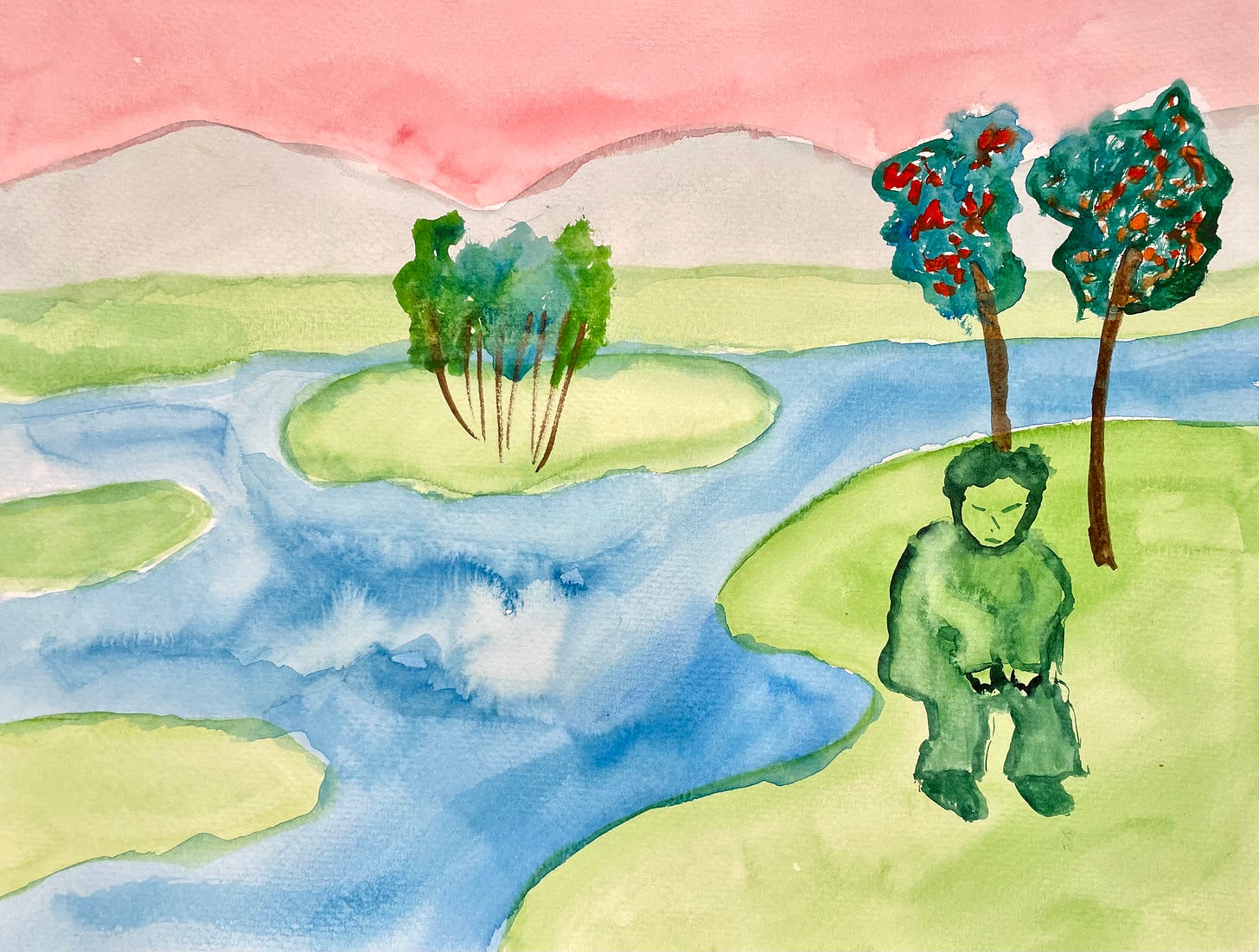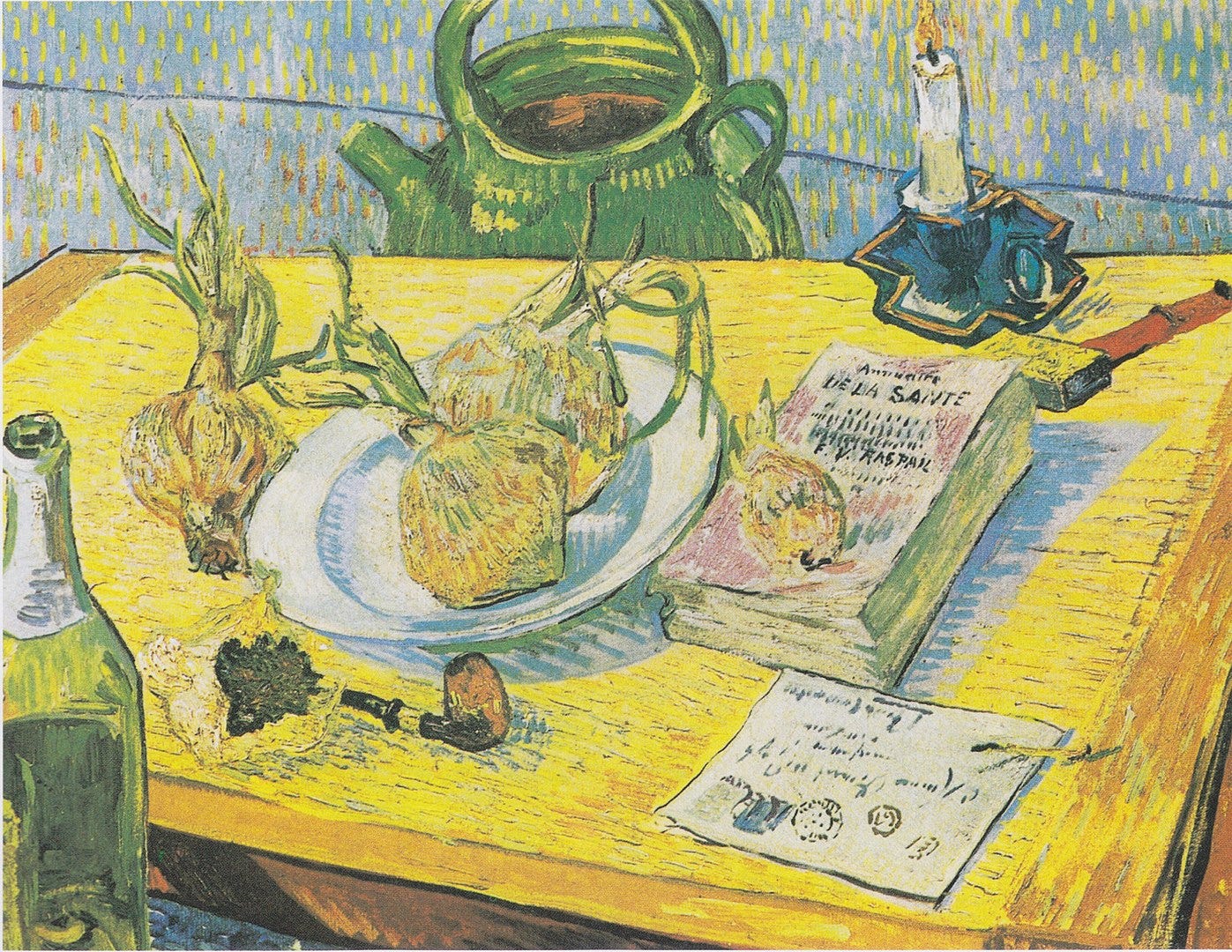Day 16 of being sick.
Day 12 of testing negative, Day 11 since I thought I was going to start feeling better.
If this isn’t Long Covid, then it might be….Medium Covid?
Whenever I’m sick, I will immediately start whining that that “I miss the world,” which is a curious response because the Kingdom of the Sick is such a real place in the world. Ram Dass says that the spiritual dimension of illness is to hold thought for everyone who’s unwell at the same time as you, which fastens you even more tightly to the world.
But I still miss, like….running down the block to buy more of that probiotic fizzy water without needing a three-hour nap afterwards.
Sickness is a vortex where hours smudge together and then at other times feel eternal. It puts a haze over anything consumed—food, TV, words—so they either lose potency or feel 100x more profound. All this, plus the dreamlike aloneness and nightmarish isolation.
During the past two weeks, I’ve had attention span only for short snippets of reading, but the sentiments are all the more precious for their scarcity.
One morning in my hours (or was it seconds?) of following rabbit holes around the internet, I came across an interview with Josh Ritter, a songwriter I’ve admired for years and years (and who I’ll see in concert tomorrow so long as I can prove not to make it a Super Spreader!) for his evocative storytelling.
Perhaps the article would have only been be a pedestrian new-album-release-interview from the Kingdom of the Well perspective, but here in my Medium Covid Kingdom, it was 100x more profound. He said,
Over time I believe we’ve changed our idea of the muses into a thing that we express our admiration of—but the muses for me are like an angry little devil on my back, and my only way of getting it off my nerves is expressing the things that come to me. Frankly, it’s not like it’s a pleasurable thing; the constant weird thoughts and intrusives. Sometimes the only way to deal with them is to be like, “I’m going to make this monster real.”
I lay my head back on my pillow (probably missing it a couple times) and rolled this phrase over a couple times like fresh dough in my mind: “Make this monster real.”
At the time, I didn’t realize why the sentiment stood out to me so much, until a few hours later when I learned that my book proposal was finally in the hands of a publisher.
Whether the editor liked it or not, I have no idea. What I do know is that I had made the monster real, and I was proud of myself for it.
You see, my next book is about animals. Well, it’s really about humans. But animals are involved. And in order to write about animals, and really about humans, I had to let my heart break..
“I can’t handle animal stuff!” I’d always say as soon as I heard any bummer tale about a whale or a pig. How much easier it was to look away than to sit with a burned, broken heart.
But I couldn’t wholeheartedly write about hummingbirds, potato bugs, lions, and mutts until I made the monster real. Living with amazement and wonder at these creatures means honoring my grief, sorrow, and guilt over the way we treat them.
So, since three days ago when I read that interview, this has become my creative mantra:
Make the monster real.
Whichever monster you dialogue with inside, whichever monster wants to face off with you in this moment: Bring the monster from the shadows into the light.
Make the monster vulnerable and feeling. Give him likes and dislikes, a distinct personality. Give him a motivation and a fear. Then write him.
This doesn’t mean art has to be all doom and gloom! For how much Van Gogh suffered, naming and exploring Beauty was perhaps subversive for him. Feasting his attention on Loveliness was his own meeting of the monster. To be so moved by a flower, Vincent had to harrow his soul and excavate all the intense emotions that lay beneath its surface.
Nor does it mean the cluttering creative space with even more labels, diagnoses, and regurgitated scripts that do nothing but let us collectively claim victimhood without exploring our own inner grit and courage to face our monsters. (What else could we expect of an adolescent society?)
I’m thinking of a chilling scene I witnessed last month at a museum when a teacher reminded her classroom to listen to a guide during their field trip. “I have ADHD, I can’t pay attention,” a boy defied with a smugness that freaked me out.
What a loss for that sweet soul if we have taught him that he is unable to pay attention (how we fall in love with life!) and given him the shield of a label so he can avoid seeing any monster in front of him. And what a loss for us that, shield blocking his head, he’s unable to kindle our curiosity and challenge our inventiveness to communicate with him in new ways.
I’ve had to learn to lower my own shields over time: Introvert, Fear of Abandonment, Anxiety, Too Sensitive, Ignorance, Phobia, Scatterbrained, and [Fill-in-the-Blank] Insecurity.
If I let my eyes peek over these shields, I see a monster in the shadows. Intuitively, I cover my whole head. Too scary.
But a shield doesn’t help me actually deal with the monster, as Josh put it. It only separates me from my creative potential. That’s when I have to make that scary guy real and get to know him.
I lower the shield and begin getting to know him. I let him scare me, I let him break my heart, or I let him surprise me with delight. Monsters are often very funny. Ultimately, I am transformed by him.
As I lay back in Starfish Pose on my bed, I thought about other creative people I’ve admired lately because I know they had to meet up with a monster in order to do their work:
Mary Shelley
The most obvious among these wrote beautifully about a created monster who embodied and expressed humans’ greatest terrors, aches, and desperations.
As someone who loves gossip, I’ve been often told in my life “Great minds talk about ideas, small minds talk about people,” but I think that is stupid!!
What’s not utterly fascinating about human desires and drives, why we do what we do, and how we choose spend our blip of existence on this complicated recondite world!?
I’ve used Frankenstein as an emotional textbook the past couple months as I’ve considered what I really want to say in my own book. The more I think about the story, the more I admire how Shelley didn’t set out to say something as much as wonder about something that most of us are far too pusillanimous to make real and then explore. She wrote an unflinching book about humans, and had to meet a monster in order to do it.
Mac Miller
In my favorite song of his, the late great Malcom stands nose-to-nose with a monster, without ever surrendering to bellicose threats. Instead, he gets to the heart of his monster’s contradictions and contrasts. “I know what’s behind that door” he admits in the elegant 2009. The song affirms that he’s known the monster very well and is here to tell the tale right alongside him.
[To witness Malcolm channel a power beyond him, watch his Tiny Desk Concert performance of this song, beginning here. Half of this song was free-styled, which astonishes me just as I’m astonished any time I experience flow: a spiritual state of communing with a place we’ve never been.]
Judy Blume
After my mom and I saw the film adaptation of Are You There God? It’s Me, Margaret, my mom commented how “Nobody talks about that stuff!” likening the movie’s themes to death and other less-than-savory topics.
Those who knew Judy Blume’s books LOVED Judy Blume’s books entirely because she talked about what others didn’t. Her characters talked like we all would too, if we could only lower our own shields:
“Are you there God? It’s me, Margaret. Gretchen, my friend, got her period. I’m so jealous God. I hate myself for being so jealous, but I am. I wish you’d help me just a little. Nancy’s sure she’s going to get it soon, too. And if I’m last I don’t know what I’ll do. Oh please God. I just want to be normal.”
If “Great Minds” talk about ideas rather than this stuff, sign me up to be a Small Mind for life!!
To make a shameful monster real and humorous was to give a million 11-year-old girls peace of mind that they weren’t alone. (And plenty of non-11-year-old-girls who also just want to be normal!)
I hope it’s obvious how Judy’s monster-revealing influenced my own:
I bow to all these Masters as I peek over my shields of sensitivity and insecurity and invite my monsters into the sunshine where I can see them in all their fuzzy glory. Our meeting becomes holy ground from which creativity springs.
I can’t write a good book unless I warmly and softly make my monsters real and give them a home. Then I allow them to reveal my essence: what I really want to say.
And I can’t get better until I go back to bed, so good night, and may you stay well!
Do you have a monster who is asking to be known? Do you have any favorite artists who made their monsters real? Have you, too, re-read Frankenstein recently? What’s in your sock?





I adore this Mari, thank you for sharing, as always. This is exactly what I want to do with my writing at the moment, to make the monsters real. For it to be unflinching, scary, raw, and brought into the light, to be seen, and heard. I’m working on it, and it’s my dream for it to be out in the world one day ❤️🔥
Your comment about the boy at the museum was eerily similar to a moment I had at a play last night. We were at an incredible adaptation of Pride and Prejudice in the front row, close enough to touch the actors. Throughout the entire first half the woman sitting next to me and her friend chatted away about inane topics that had nothing to do with the play. When I asked them to please be quiet they both scowled at me, but acquiesced.
In the intermission, the friend approached me to "apologise" and said "she can't help it; she has ADHD. It would be compassionate of you as a fellow theatre-goer if you accommodated that".